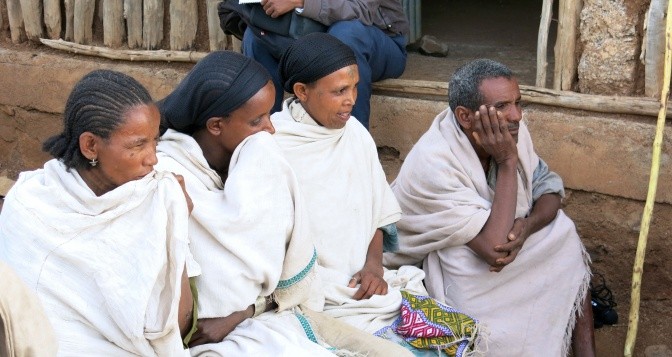There are many gender mainstreaming workshops that take place each year. Few are successful at motivating behavior change. But a workshop in Gondar, Ethiopia was different. Some researchers came to argue that gender mainstreaming isn’t necessary. They left as supporters of the approach. (Watch the video)
Why did this change occur?
Just telling people to include women doesn’t work.
Over 50 participants attended the workshop, all young, mostly male, Ethiopian researchers from surrounding agricultural research centers. The workshop focused on learning by doing. Instead of endless powerpoint presentations, participants engaged in interactive exercises (see examples below) and field visits that encouraged discussion and debate.
“We took researchers to a farming community in the region that they knew well. They knew the community members but assumed that what the men said was sufficient for their research,” said Beza Desalegne of the International Center for Agricultural Research in the Dry Areas (ICARDA).
In the community, researchers facilitated three separate focus group discussions with all male farmers, all female farmers, and a one group of male and female farmers. They asked these groups the same questions and came back with different answers from each. There were many issues that the community faced that the researchers were unaware of, despite having worked there for years.
What difference does it make?
“It’s obvious that men and women have different preferences; this seemed to be well understood. But what isn’t well understood is how their different preferences can influence research and development projects,” said Beza.
Take, for example, the implementation of water harvesting technologies. If the technology requires operation after dark, women may be prevented from operating them. Similarly, if women are responsible for irrigation but only male farmers are trained to use the technology, there will be much lower rates of adoption.
In this particular field visit, researchers realized that women were much more vocal when in a discussion group of only females. This is something that has been observed in numerous studies and repeatedly advocated for in gender mainstreaming approaches: when men and women are separated into separate discussion groups, women are more comfortable and vocal in expressing their opinions.
Participants also came to understand one of the major burdens faced by women is fetching firewood for cooking. Because of deforestation, they spend much of their day and energy collecting firewood. ICARDA is now working to introduce fuel-saving stoves to their project in this region.
Setting the Scene
In addition to the field trip, highlighted in the video above, a number of activities lay the foundation for much of the experiential learning in the workshop.
I find it rare to attend workshops in which there are heated debates in each session. The following activities were valuable both in igniting discussion and in building a better foundation with which to understand the importance of gender mainstreaming activities in research and development.
Activity 1: Sex and Gender; Equity and Equality
Objective: To ensure the proper understanding of the definitions and applications of terms frequently used in gender mainstreaming
Researchers were given a number of different descriptions and asked to identify if they were referring to sex or gender.
For example: Is this a statement regarding gender or sex?
Girls should be gentle; boys should be tough
(Answer: gender)
Activity 2: The 24 Hour Day
Objective: To better understand the division of labor in and outside the home; the amount of time taken up by the various tasks; and to gauge the difference in workloads.
Participants were asked to list tasks done by men and by women (separately) by hour. Participants had an easier time identifying activities done by men and were generally surprised by how many more tasks they listed for women.
After looking at our completed activities, the facilitator noted that many of the women’s activities are difficult to fit into hour-long time slots. For example, taking care of the children is a full-time activity, which typically means women are completing multiple tasks at once. This was seen much less often on the male activity list.
Activity 3: Gender Roles & the Valuation of Labor
Objective: To see which of the regular activities garner recognition, reward (financial or otherwise), status etc. and thereby understand how gender roles play into the valuation of labor
This activity was particularly enlightening to all of us in attendance at the workshop. We took the list of activities generated in Activity 2 and determined if the task was done by either males or females, if the task was rewarded, biological or cultural, and high or low status.
For example, taking care of children is a task done by females, it is cultural, not rewarded (i.e. it is unpaid), and medium or low status. Alternatively, harvesting was a male task, cultural, rewarded, and high status.
Adopted from Training Manual on Gender Mainstreaming, PREEEP, UGANDA
For more information about the workshop, please contact Beza Desalegne of ICARDA, B.Dessalegn(at)cgiar.org, or Kuleni Berhanu, Trainer, kuleni.berhanu(at)gmail.com.












